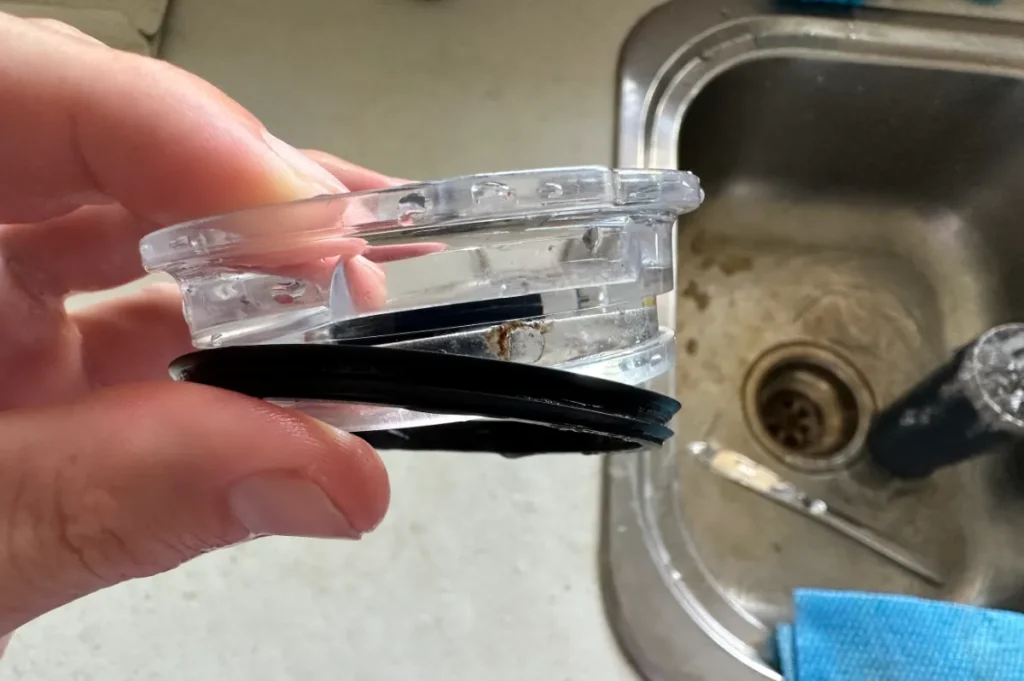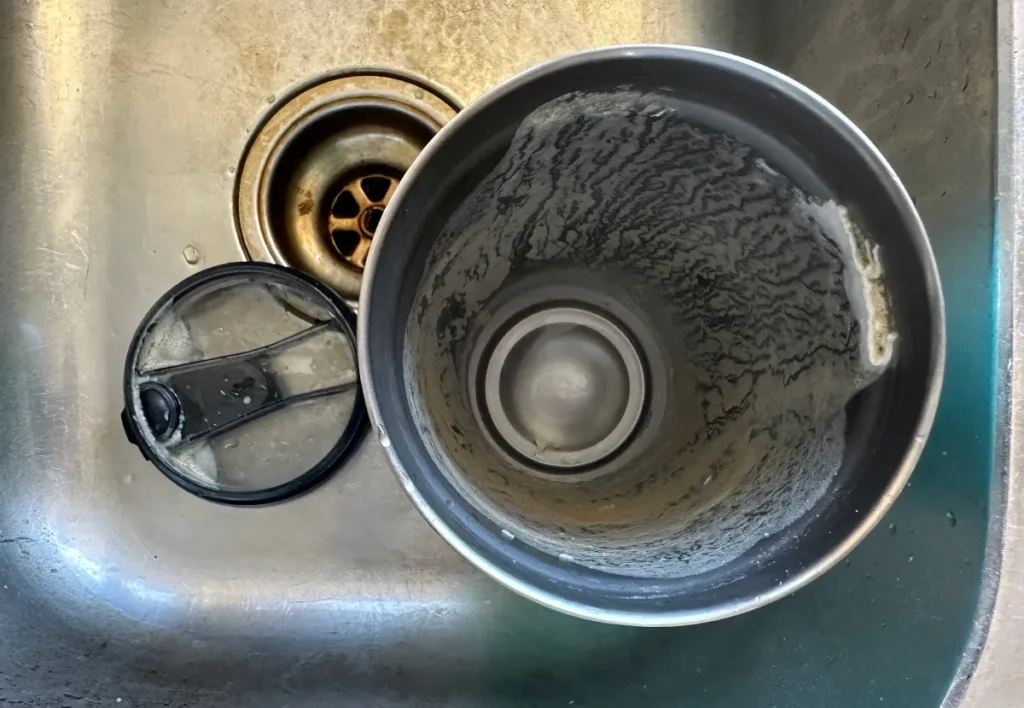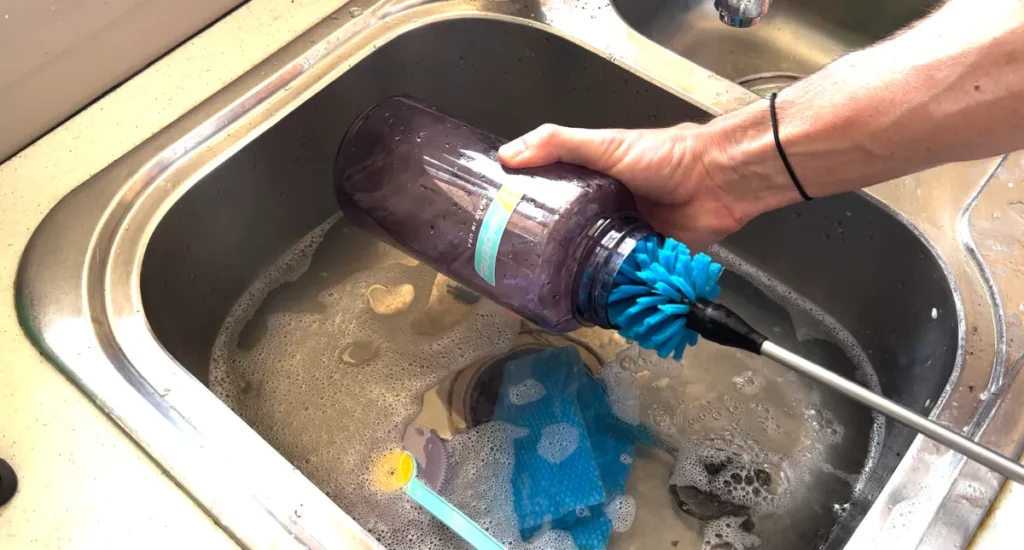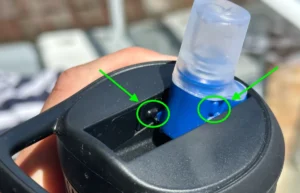I decided to deep clean my daughter’s Contigo bottle last week and when I dismantled the lid to get to the hidden dirt, I noticed a concerning amount of mold.
A few months back my Hydro Flask bottle started smelling a bit musty and funky but there were no visible signs of mold.
There are a few tell-tale signs that you have mold in your water bottle, and not all of them are obvious.
You have mold in your water bottle if you notice black, green or grey spots or a slimy or fuzzy film. The bottle may also have a musty, earthy and unpleasant odor or there could be unexplained dark floaters in the water.
If you don’t clean your bottle and lid every few days and deep clean it and treat for mold monthly, there’s a good chance it has mold – even if you can't see it.
If your lid has a spout or straw or rubber gasket then these are areas that can grow mold rather quickly and you need to stay diligent about cleaning and drying them thoroughly.
Learning to recognize mold in your water bottle can help protect you and your family against the dangers that mold poses, such as respiratory or digestive issues.
How To Know If You Have Mold in Your Water Bottle
Some signs of mold are extremely obvious, while other signs are a bit more subtle that you need to pay close attention to recognise.
Here’s how to tell if you have mold in your water bottle:
1. There Are Black, Green or Grey Spots

The dark and wet conditions in a water bottle and especially its lid is the perfect breeding ground for mold.
When mold first takes hold, it releases spores as it multiplies. After the microscopic spores have multiplied enough, you’ll notice black, dark green or grey spots (the color depends on the mold variety).
Common areas to look for mold are under the rubber gasket in the lid, in the threads of the lid, base of the bottle and any straws or spouts your water bottle might have.
Once you notice these spots, it means that the mold is actually already quite severe and you've likely been drinking mold from your water bottle for some time now.
You’ll need to deep clean your bottle. I’ve written a guide to removing mold from a water bottle that you can check out if you need help.
2. You Have White Fungus Like Growths

There are different types of mold and while black mold is one of the more common types of mold you'll find in your water bottle you can also develop a white mold.
If you have white mold in your water bottle chances are you've used your bottle for something other than water. Soda, smoothies, alcohol, coffee, tea and a variety of other drinks all have the potential to grow white mold if you don't wash them soon enough or well enough.
Above you can see the white mold that grew in my RTIC tumbler after I drank a smoothie from it and then proceeded to leave it rolling around in the back of my car for the next 5 days.
If you find white mold in your water bottle you'll need to give it a thorough clean to remove any mold residue but you'll also need to treat it for mold to make sure all spores are killed off.
5. Your Bottle or Lid Has a Musty, Earthy and Unpleasant Odor

Sometimes you can smell the mold before you can see it. This is what happened to me with my favorite Hydro Flask water bottle.
I use this water bottle almost daily and I regularly wash it in warm soapy water and dry it. But over time I started to notice a musty weird smell as I was drinking my water.
As mold grows in your water bottle, you’ll notice an earthy, musty or generally unpleasant odor coming from it. Some people describe it as rotting vegetation or having an ammonia smell.
The earlier you catch it the more mild the smell is. For me it started as hardly noticeable and then eventually became overwhelming to the point where I couldn't breath in through my nose as I drunk my water.
The smell comes from the spores the mold releases and they can be harmful if you breathe them in continuously or if you have respiratory problems, like asthma.
Turns out I was drinking mold and didn't even know it. There were no visible signs in my bottle – just the smell.
If you deep clean your bottle and treat it with a mold killer (like I did with my daughter’s Contigo bottle), the smell should quickly go.
4. There Are Unexplained Dark Pieces Floating in the Water
I’ve used reusable bottles for years and I’ve noticed that most of the grime and mold is usually hidden in the lid or behind the lid’s gasket. It's one of the major problems with Contigo bottles and is a common gasket problem in a variety of brands.
This means the mold can go unseen for month and grow unhindered in the hidden parts of your lid. Check the disgusting state of the Contigo bottle lids below. Most of that mold was completely hidden until the lid was pulled apart.
This hidden mold can sometimes get dislodged when you open and close the bottle and fall into the water. I
f you notice unexplained dark bits in your water, DON'T DRINK IT and give your bottle a deep clean immediately to get rid of the mold before using it again.
Make sure you find the source of the mold and treat it. Don't trust the dishwasher or soapy water you need to actually remove the mold and treat it.
The dark bits are probably mold and can make you feel nauseous or have diarrhea if you ingest them.
5. There’s a Fuzzy or Slimy Film Inside the Bottle or Lid
Mold has a soft consistency and as it grows, it can take on a fuzzy or slimy texture. This is called biofilm and is a strong indicator that your bottle or lid has a mold infestation.
This may not be visible to the naked eye but you may be able to feel it with you fingers when you wash or empty your bottle.
If you notice a delicate film or the inside of your bottle feels a bit slimy, don’t use the bottle until you’ve given it a deep clean (this includes the lid).
Cleaning away biofilm can be tricky but these tips to clean a cloudy water bottle work great for biofilm as well. Primarily on the inside of your bottle (which can be hard to reach and clean properly).
Just make sure to also treat with vinegar or a mold killer as well to make sure it's all gone.
If you have an old complicated spout lid, you open it and notice a lot of mold, consider if it would be worth it deep cleaning it or investing in a new lid or bottle instead.
With so many good bottle brands currently on the market, you’d be amazed at the variety and affordable prices.
Click here to see the best lids for Hydro Flask bottles
Click here to see the best lids for Nalgene, CamelBak, Contigo and similar bottles
6. You Don’t Clean the Bottle or Lid As Often As You Should

I get it – life happens and you don’t always have time to clean your water bottle every day.
Unfortunately, being slack on cleaning is a surefire way to get mold in your bottle eventually. If you haven’t been cleaning your bottle as often as you should, it’s a good sign you have mold, even if you can’t see or smell it.
I’ve been there but when I discovered bottle cleaning tablets (a hands-off cleaning method), my life got a lot easier. All you do is rinse the bottle, fill in with water and drop a tablet in.
All natural, safe, free of odor and harmful ingredients. This is perfect for cleaning tumblers and water bottles giving them a fresh look and smell. No scrubbing required. Made in the USA
It’s best to wash water bottles in hot water and dish soap. However, putting them through the dishwasher (if they’re dishwasher safe) or using a bottle cleaning tablet is second prize and still better than not washing it at all.
Washing your bottle at least every 2 to 3 days can help prevent mold growth and giving it a deep clean once a month gets to all the hidden crevices that mold loves.





